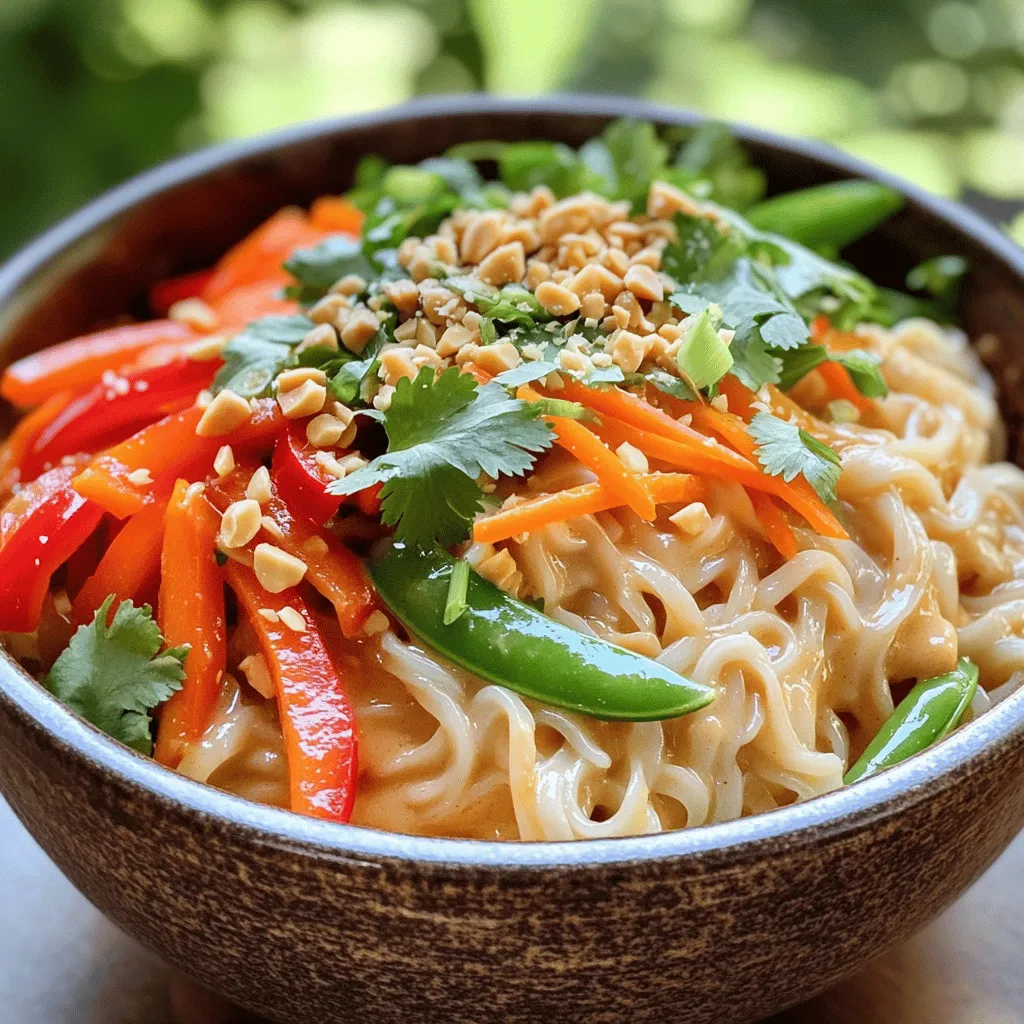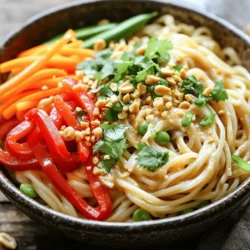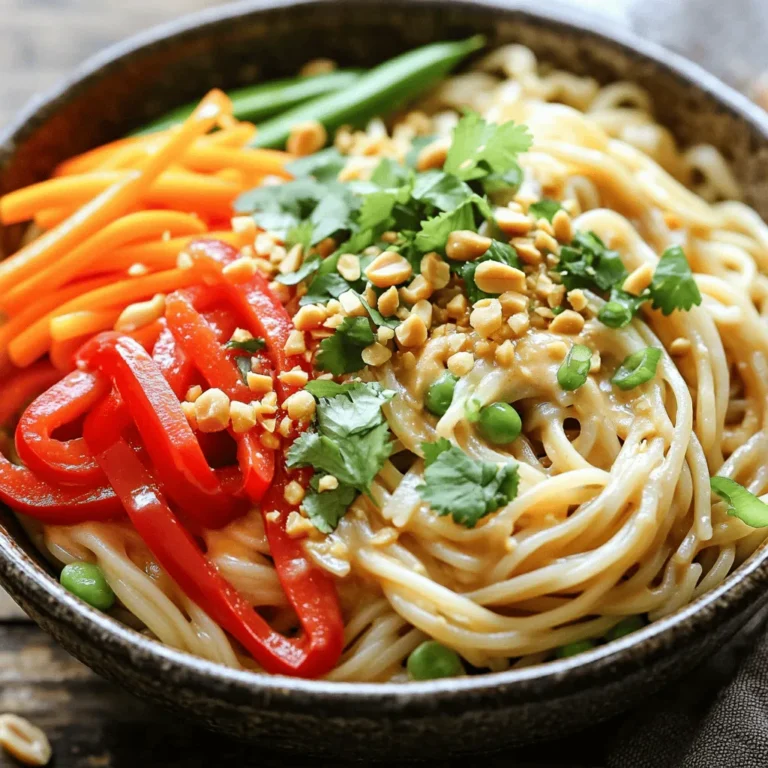Looking for a quick and tasty meal? You’ll love this Spicy Thai Peanut Noodles recipe! With just a few simple ingredients, you can whip up a flavorful dish that’s satisfying and fun to make. This recipe combines creamy peanut sauce with fresh veggies and rice noodles, perfect for dinner or lunch. Let’s dive in and create a delicious dish that will impress your family and friends!
Ingredients
Main Ingredients
– 8 oz rice noodles
– 1 tablespoon sesame oil
– 1 red bell pepper, sliced into thin strips
– 1 carrot, julienned into matchstick pieces
– 1 cup sugar snap peas, trimmed and halved
– 3 green onions, chopped (both white and green parts)
– 1/4 cup fresh cilantro, finely chopped
Peanut Sauce Components
– 1/2 cup creamy peanut butter (smooth is ideal)
– 1 tablespoon soy sauce (low-sodium recommended)
– 2 tablespoons fresh lime juice (about 1 lime)
– 2 tablespoons honey or maple syrup (for vegans)
– 1 tablespoon sriracha sauce (adjust according to your spice preference)
– 1 clove garlic, minced
– 1/4 cup warm water (for adjusting consistency)
Optional Garnishes
– Crushed peanuts
– Extra cilantro for garnish
– Lime wedges for serving
Spicy Thai Peanut Noodles need fresh and bright ingredients. Rice noodles are the base. They soak up the rich sauce well. The sesame oil adds a nutty flavor and helps cook the veggies.
For the veggies, I love using red bell pepper, carrot, and sugar snap peas. They add crunch and color. Green onions and cilantro finish the dish with freshness.
The peanut sauce is key to this dish. Creamy peanut butter brings richness. Soy sauce adds saltiness, while lime juice gives a zesty kick. Honey or maple syrup balances the flavors with sweetness. Sriracha adds heat, but you can adjust it to your liking. Garlic rounds out the sauce with depth.
For garnishes, crushed peanuts give a lovely crunch. Extra cilantro adds brightness, and lime wedges are perfect for squeezing fresh juice on top.
Step-by-Step Instructions
Cooking the Noodles
– Boil salted water and cook rice noodles.
– Drain and rinse with cold water.
Start by boiling a large pot of salted water. This step is key for flavor. When the water boils, add 8 ounces of rice noodles. Cook them for about 4 to 6 minutes until al dente. This means they should be firm but not hard. Once they are cooked, drain the noodles and rinse them with cold water. This stops the cooking process. Set the noodles aside in a bowl for later use.
Making the Peanut Sauce
– Combine ingredients in a bowl.
– Adjust consistency with warm water.
Next, grab a medium mixing bowl. In this bowl, combine 1/2 cup of creamy peanut butter, 1 tablespoon of soy sauce, and 2 tablespoons of fresh lime juice. Add 2 tablespoons of honey or maple syrup and 1 tablespoon of sriracha. Finally, toss in 1 minced garlic clove. Whisk these ingredients together until smooth. If the sauce is too thick, add 1/4 cup of warm water. This helps you reach your desired sauce thickness.
Sautéing the Vegetables
– Heat sesame oil in skillet.
– Stir-fry red bell pepper, carrot, and sugar snap peas.
In a large non-stick skillet, heat 1 tablespoon of sesame oil over medium heat. When the oil is shimmering, add the sliced red bell pepper, julienned carrot, and sugar snap peas. Stir-fry these veggies for about 3 to 4 minutes. You want them to stay bright and crisp.
Combining Ingredients
– Mix noodles with sautéed vegetables.
– Toss with peanut sauce until well coated.
Now it’s time to bring everything together. Add the cooled noodles to the skillet with the sautéed vegetables. Drizzle the peanut sauce over the noodles. Use tongs or two forks to gently toss everything. You want the noodles to be well-coated with the sauce and the veggies mixed throughout.
Final Touches
– Add green onions and cilantro.
– Serve with garnishes.
Remove the skillet from heat. Mix in 3 chopped green onions and 1/4 cup of finely chopped cilantro. Toss again for even distribution. Now, serve your spicy Thai peanut noodles in bowls. Top with extra crushed peanuts for a nice crunch. Enjoy the vibrant flavors and textures in each bite.
Tips & Tricks
Cooking Perfect Rice Noodles
– To cook rice noodles, bring salted water to a boil.
– Cook noodles for 4 to 6 minutes until al dente.
– Avoid overcooking to keep them firm and chewy.
– After cooking, drain the noodles and rinse with cold water.
– Rinsing stops the cooking and helps keep the noodles separated.
Enhancing Peanut Sauce Flavor
– For a spicier sauce, add more sriracha to taste.
– If you want less heat, use less sriracha or skip it.
– Try using honey or maple syrup for sweetness.
– Each sweetener gives a slightly different flavor.
– Taste as you mix, and adjust until it’s just right.
Presentation Advice
– Serve the noodles in deep bowls for a fun look.
– Use colorful garnishes for added visual appeal.
– Fresh cilantro and extra crushed peanuts work well.
– A lime wedge adds a nice pop of color and flavor.
– A beautiful dish makes it more enjoyable to eat.

Variations
Vegetarian or Vegan Options
You can easily make this dish vegetarian or vegan. Simply replace honey with maple syrup. This swap keeps the sweetness while making it plant-based. You can also add tofu or tempeh for protein. Both options soak up flavor and add a nice texture.
Ingredient Swaps
Feel free to get creative with your veggies. You can use different vegetables like broccoli or bell peppers. Both options add color and crunch. If you want a low-carb twist, substitute rice noodles with zucchini noodles. Just spiralize the zucchini and sauté until tender.
Adjusting Spiciness
Not everyone enjoys a lot of heat. You can use milder sauce options if you prefer. Try a sweet chili sauce instead of sriracha. You can also incorporate other spices or chili sauces to control the heat level. Always taste as you go to find your perfect balance.
Storage Info
Refrigeration Tips
Store any leftovers of your Spicy Thai Peanut Noodles in an airtight container. This helps keep them fresh. Try to eat them within 3 days for the best taste and quality.
Freezing Recommendations
You can freeze the noodles, but they may change texture. To freeze, place them in a freezer-safe container. When you want to eat them, thaw the noodles in the fridge overnight before reheating.
Reheating Guidelines
The best way to reheat your noodles is on the stove over medium heat. This method keeps them from getting dry. Add a splash of water while reheating to maintain moisture. Enjoy your delicious meal again!
FAQs
What can I serve with Spicy Thai Peanut Noodles?
You can pair these noodles with a light side salad or crispy spring rolls. The fresh crunch of a salad complements the rich flavors well. Spring rolls add a nice touch of texture.
Can I use a different type of noodle?
Yes, you can use other noodles like soba or udon. Both options have great flavor and texture. Soba noodles offer a nutty taste, while udon noodles are chewy and filling.
Is this dish kid-friendly?
This dish can be made kid-friendly. Simply lower the spice by using less sriracha. You can also serve the sauce on the side for those who want less heat.
Can I make the sauce ahead of time?
Absolutely! You can prepare the peanut sauce ahead of time. Just store it in the fridge in an airtight container. It stays fresh and tasty for up to a week.
Where does Spicy Thai Peanut Noodles originate?
This dish comes from the streets of Thailand. It features a combination of bold and rich flavors. Street food like this is loved for its quick preparation and delicious taste.
You now have a clear path to making Spicy Thai Peanut Noodles. We covered the main ingredients and their roles. You learned how to cook the noodles and make the sauce. Sautéing fresh veggies adds flavor and crunch. Remember, adjust the spice level to your taste. Feel free to mix in different veggies or proteins. Store leftovers for easy meals later. Enjoy this vibrant dish that brings a taste of Thailand to your kitchen. Happy cooking!


